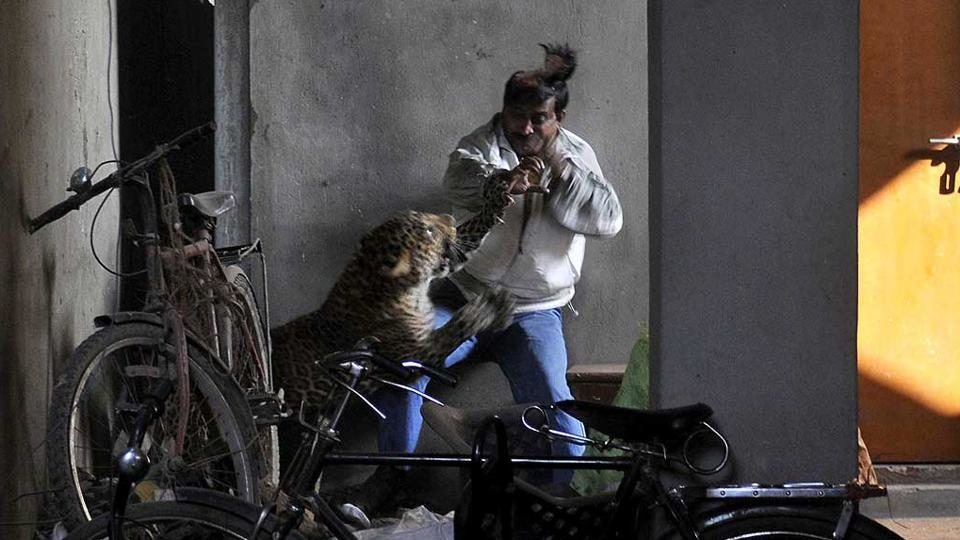
© AFPA leopard attacks and wounds a man in Silphukhuri area in Guwahati. (File photo)
reveals data from the ministry of health and family welfare. This means an average of 28 people died every day across the country in five months.
While Madhya Pradesh had the most deaths (792), West Bengal and Maharastra were second and third with 576 and 439 deaths. In Maharashtra, 27 of the deaths were in urban areas.
Between April 2016 and March 2017, the number of deaths owing to animal attacks across the country was 7,556, and Maharashtra accounted for 651 of these deaths. In Maharashtra, Amravati district had the maximum cases (47) followed by Mumbai and Pune, which had 26 deaths each.
In Mumbai, this year, there have been two snake bite deaths - one in July, when a 20-year-old woman died after being bitten while she was asleep and the second in October, when a six-year old boy living in Aarey Milk Colony died after being bitten while playing with friends. Also, on July 22, a two-year-old from Aarey was killed by a leopard.
"We collated data from public and private hospitals across the country. But the data does not have details of which animals were responsible for the deaths," said an official from the Ministry of Health and Family Welfare.
"According to our baseline studies, we estimate that 80% cases between 2015 and 2017 are owing to dog bites, 5% of snake bites, 3% of monkey attacks, remaining from wild animals such as jackals, leopards, wild boars, tigers, elephants, etc., and a small percentage of cases are of rat bites, bull, cow or other cattle attack incidents."
Experts were suspicious about the data,
saying that it was not clear whether the deaths attributed to dogs were due to rabies."These are very serious matters concerning human lives and there needs to be a detailed scientific analysis, especially in rural areas, because municipal or public hospitals are submitting data based on the dosage of medication. In some cases, one person is given five doses and it is accounted as five dog attacks whereas it is actually one. It is also not clear whether it is a stray or a pet dog," said Rahul Seghal, director, Asia and Africa, Humane Society International, an international organisation that works for animal protection.
Members of the Maharashtra State Animal Welfare Board said since most deaths were owing to dog bites, the health ministry should make rabies a reportable disease. Disease that are considered a public health concern have to be reported by doctors to the public health system so that preventive measures can be taken.
"Rabies and snake bite deaths are the most preventable deaths and can be mitigated through basic anti-rabies programme. The central government needs to make rabies a notifiable disease and come out with specific data rather than accumulating individual deaths," said NG Jayasimha, member, Maharashtra animal welfare board. "The reason why maximum cases have been reported in rural areas is because they leave the wound unattended and it slowly transforms into a disease and ultimately death."
Jayasimha said snake bite deaths are caused by fear psychosis rather than due to venom. "There are five varieties of venomous snakes in India and therefore in a large number of cases, mostly in rural areas, villagers fall prey to these incidents during open defecation. Further, they have their own ways and means of treating these issues rather than looking for a hospital," he said. "In most urban areas, the availability of anti-venom vials has increased in major public and private hospitals. There is need for more awareness and a detailed action plan is underway with the central government to mitigate these issues."
According to the Humane Society International (HSI), the World Health Organisation (WHO) in 2000 had come out with a report that estimated 20,000 people die in India due to rabies and the main vector is the dog. However, recent central government reports have indicated that the deaths have reduced to 3,500 annually.
"According to this data, it seems that rabies is not a concern for India anymore. However, this is not the case and rabies still exists as a prevalent threat to humans. There is need for on-ground data by scientists and the current animal bite segment is being given as a punishment posting from the health department to people that are coming up with this data," said Seghal.
Beasts?